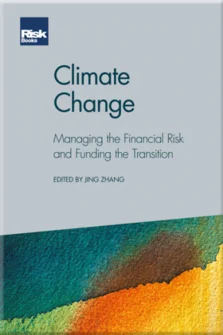Modelling climate physical risks
Dapeng Hu, Mark Hu, Amit Madaan and Shubhin Puri
Modelling climate physical risks
Foreword
Introduction
Sustainability for critical ecosystems: The future of risk management – more of the same or a new paradigm?
Climate change is a source of financial risk
The climate disclosure landscape in the finance sector
Green boxes? An overview of climate risk tools and analytics
Embedding climate change in financial metrics
Modelling climate physical risks
Climate-related stress-testing: Transition risks
Catastrophe risk modelling and climate change
Evidence-based climate stress testing
Climate risk drives a new paradigm in risk management
Incorporating climate change in asset allocation and portfolio construction
(Car)bon voyage: The road to low-carbon investment portfolios
Climate risk primer for community banks: Concepts and policies during a period of significant change
Next-generation analytics for climate finance
Climate finance post-COP26
Mobilising private funding
Investment risk associated with physical changes of the world – from rising temperature and sea levels to the increasing frequency and intensity of extreme events such as hurricanes, wildfires and floods – has been well known by the financial industry. Yet, the implications for security selection, portfolios construction and risk management have been notoriously hard for investors to grasp. The effects of slower-moving physical changes such as rising sea levels can seem distant, causing investors to discount pressing climate-related risks already lurking in portfolios; the risks are hard to quantify or even to measure systematically. New climate patterns caused by climate change mean long-dated historical data alone can be a problematic guide to the future, and investors using models overly reliant on the past may miss the long-run climate trend. Further, although drilling down on physical risk to the exact geographical location and asset level is key to investors, analysing huge amounts of climate data properly and effectively has been challenging as it requires a combination of climate science, economics, finance and data science knowledge and tools.
BlackRock has conducted
Copyright Infopro Digital Limited. All rights reserved.
As outlined in our terms and conditions, https://www.infopro-digital.com/terms-and-conditions/subscriptions/ (point 2.4), printing is limited to a single copy.
If you would like to purchase additional rights please email info@risk.net
Copyright Infopro Digital Limited. All rights reserved.
You may share this content using our article tools. As outlined in our terms and conditions, https://www.infopro-digital.com/terms-and-conditions/subscriptions/ (clause 2.4), an Authorised User may only make one copy of the materials for their own personal use. You must also comply with the restrictions in clause 2.5.
If you would like to purchase additional rights please email info@risk.net











